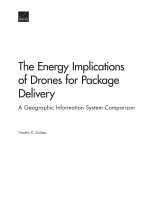| 来源类型 | Research Reports
|
| 规范类型 | 报告
|
| DOI | https://doi.org/10.7249/RR1718.1
|
| 来源ID | RR-1718/1-RC
|
| The Energy Implications of Drones for Package Delivery: A Geographic Information System Comparison |
| Timothy R. Gulden
|
| 发表日期 | 2017
|
| 出版年 | 2017
|
| 页码 | 23
|
| 语种 | 英语
|
| 结论 |
Shifting smaller-package delivery from trucks to drones results in a net savings of 5.7 percent of the overall energy used.- We found that shifting 20 percent of delivery stops from trucks to drones would require 13 fewer truck routes, 468 fewer truck miles, and (assuming an efficiency of 10 miles per gallon) 46.8 fewer gallons of diesel fuel. The drone delivery would involve 1,550 drone trips, totaling 9,406 miles flown. Assuming a tilt-rotor fixed-wing design, other work in this project suggests a delivery drone fuel economy of 460 miles per gallon equivalent, allowing all the deliveries to be conducted with the energy equivalent of 20.4 gallons of diesel. This results in a savings of 26.4 gallons of diesel, for a net savings of about 5.7 percent.
Drones may be an energy-saving way to deliver light packages, although they are unlikely to replace trucks for heavier items.- The savings come primarily from the fact that trucks are vastly heavier than drones. By using drones to deliver only the lightest packages, the deliverer is able to free the truck, with its greater weight and additional cargo, from the additional driving required to deliver that small package. Reducing the number of service areas also reduces the amount of driving required for the trucks.
- Drone energy use would be entirely electric. Depending on the sourcing of this power, it would be expected to have a much lower carbon footprint and to produce less local air pollution as well.
|
| 摘要 |
- While the numbers and calculations in this preliminary study are rough, the analysis supports the idea that the energy requirements for truck and drone delivery for small packages are of the same order of magnitude and, thus, that shifting some deliveries to drones would not have a major impact on the energy intensity of package delivery. However, it would shift this energy from diesel-burning trucks to electric drones, which might have a beneficial impact on the carbon footprint of package delivery until the delivery truck fleet can be converted to lower-carbon fuels. While practical considerations of noise abatement and airspace restriction might reduce this efficiency somewhat, rapid advances in battery technology and drone design can be expected to produce more than offsetting increases in efficiency.
|
| 主题 | Civilian and Commercial Drones
; Energy Consumption
; Surface Transportation
|
| URL | https://www.rand.org/pubs/research_reports/RR1718z1.html
|
| 来源智库 | RAND Corporation (United States)
|
| 引用统计 |
|
| 资源类型 | 智库出版物
|
| 条目标识符 | http://119.78.100.153/handle/2XGU8XDN/108635
|
推荐引用方式
GB/T 7714 |
Timothy R. Gulden. The Energy Implications of Drones for Package Delivery: A Geographic Information System Comparison. 2017.
|
|
文件名:
|
x1520277947618.jpg
|
|
格式:
|
JPEG
|

|
文件名:
|
RAND_RR1718z1.pdf
|
|
格式:
|
Adobe PDF
|
除非特别说明,本系统中所有内容都受版权保护,并保留所有权利。